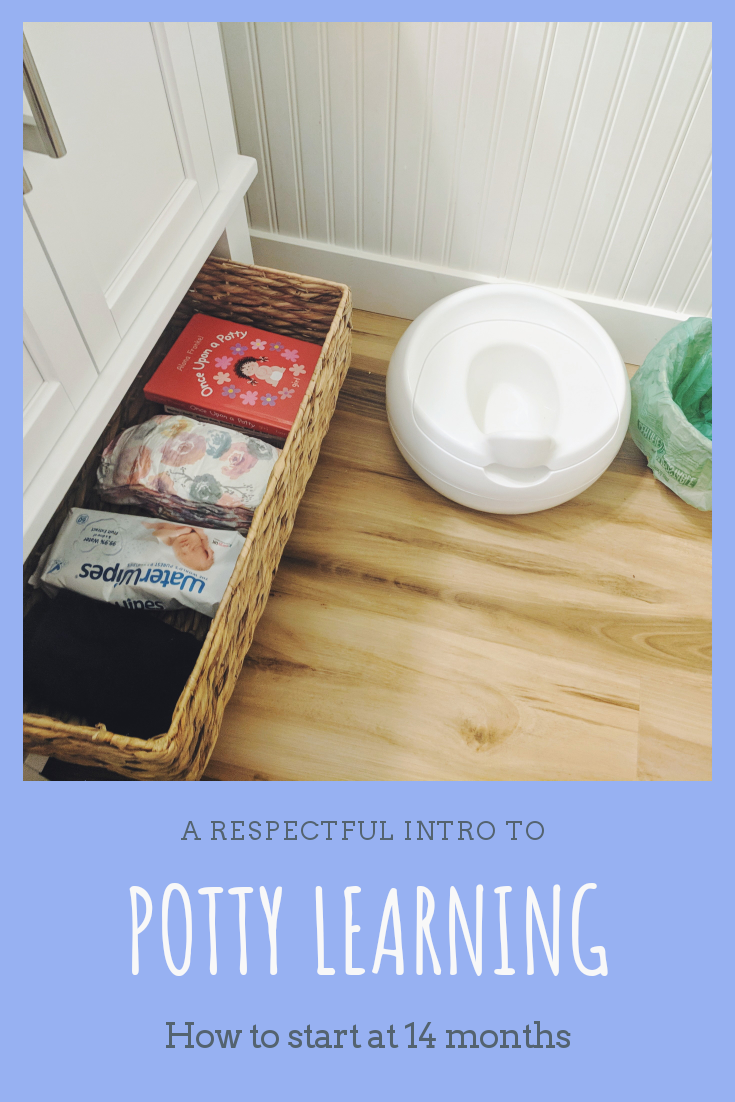The Ups and Downs of Potty Learning
Montessori in Real Life
Spoiler alert: If you are hoping for how to potty train in 2 days, this is not the post for you! ;) We began “potty learning” when D was about 14 months old. You can read about how we began in this previous blog post, which helps explain the why’s and how’s of our method. Since then, I’ve been getting questions about how it’s going now, especially given that she is wearing underwear in many of our photos! Here is our potty learning update, at 19 months.
Though we have a potty set up for her in two bathrooms (one upstairs and one downstairs), she primarily uses the one downstairs, because that’s where she plays and we spend most of our time. It is a small half bath, but we’ve made it work! It’s worth it to squeeze the potty in this bathroom rather than just place it in the hallway, because it helps to familiarize her with the bathroom as the appropriate place to go. The potty we use is this one by Joovy Loo but many love the Baby Bjorn one, which is a little lower to the ground and is narrower.
Since we began 5 months ago, we’ve had many ups and downs, especially during sickness, travel, or developmental leaps. Luckily, having spent countless hours in the bathroom with toddlers as a teacher, this didn’t come as a surprise to me. Especially when starting at a young age, getting familiar with using the potty takes time, practice, and backwards steps (hopefully along with a few more forward steps). Despite what potty training books say, it doesn’t usually happen over the course of a weekend. The good news is it also doesn’t have to require bribes, punishments, or being stuck in the house for three days.
Over the past few months, D has been wearing underwear more and more. She exclusively wears underwear at home, except when she sleeps. Now that she’s able to control her bladder more, she also wears underwear for short outings. We skipped pull-ups all together, because I find they are a confusing mix of diapers and underwear. The big benefit of underwear over diapers/pull-ups is that toddlers can feel that they are wet, and typically, they don’t want to be. Our favorite underwear are these ones made by Kickee Pants. They are pricey but hold up well, even being washed over and over again! We also have a set of these thicker undies, but they don’t fit as well and are possibly too absorbent. At home, she often wears these without pants because it makes it easier for her to help take them off and sit independently/quickly.
While we started off by inviting D to use the potty, we’ve now moved on to posing it as a statement. “It’s time to sit on the potty now”. This works best once it becomes a routine. She knows that after mealtimes, before bed, and before outings, she sits on the potty. She doesn’t typically resist those times. However, if I ask her to sit on the potty before eating, or right after nap, she resists, because it’s not part of her routine (yet). She doesn’t have to sit for long, but she knows she has to try. Other times, she’ll tell me she has to go, or walk to the bathroom herself. I can’t count on that consistently yet though!
Our best friend in all this is books. D gets to pick her book of choice before walking to the bathroom. We also keep a few books for her to choose from in a basket there. It’s a good excuse for me to stop what I’m doing and simply read with her. She always points out when she’s made a pee or poo on the potty and then we dump it into the toilet. She gets to pick out a pair of underwear (I keep 2 or 3 choices out at a time), and I help her get them back on. Then we wash our hands together. She is getting more independent in this process each week.
When she does have an accident, we go to the bathroom, take off her wet underwear, and if just a little wet, she puts them in a small laundry bin. Then she sits and we start the process of sitting/re-dressing. I don’t make a big deal of it if she is wet, and I definitely don’t make her feel bad about it. I say “It looks like you are wet. Let’s go to the bathroom and get dry.” She usually points out that she’s peeing or she’s wet before I say anything, and wants to get dry underwear on.
Next up is tackling our longer adventures away from home. Though she currently still wears diapers for those outings, I am finding recently that she can stay dry longer. To transition away from diapers, I’m planning to buy a few of these underwear covers, so that she can still feel wet, while not soaking through her clothes. I also plan to keep a potty in the back of our car. Updates to come, hopefully before this next baby arrives, and we will most definitely hit another regression! ;)
* Update (April, 21 months): No longer in diapers for outings! Only for sleep. She does well with this travel potty and always keeping an extra pair of underwear in the bag and car. We definitely have more accidents out and about than at home (routine thrown off), but getting there!
Note: This post contains affiliate links. If you purchase a product through one of these links, you won’t pay anything extra, but I will get a small commission, which helps keep this blog going. Thanks for supporting Montessori in Real Life!







